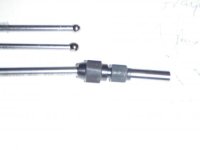Lots of guys like and use the grizzly rods that Gordy developed a few years back. One of the biggest gripes and what I didn't care for, was having to hold one end in a drill chuck, mounted in the tailstock.
My take is you have to be inducing some flex into the setup (Grizzly rod) as the bore wanders when dialing in, albeit minimal. This is due to the Grizzly rod being held somewhat rigid in the chuck on one end while the piloted end follows the bore.
I'm not scientific, so I don't want to get involved in a lengthy, pick my method apart discussion. But I just wanted to share this because a lot of you guys do your own work, and I have had a lot of help over the years from some great smiths that were generous enough to give out info.
What I did to remedy this was....mill out some 5/16ths ball bearing and fit them to the end of each Grizzly rod.
This allowed me to mount that end in my Starrett No#828 wiggler, and then hold the wiggler with the chuck in the tailstock. This allows 360 degree movement of the rod at that end. Resulting in better indication.
I used high rpm and Garr tool carbide endmills in sizes 13/64, 15/64 and 17/64ths.
One was a press fit, the other was tight enough that I used Loctite 609. The other I used some JB weld.

My take is you have to be inducing some flex into the setup (Grizzly rod) as the bore wanders when dialing in, albeit minimal. This is due to the Grizzly rod being held somewhat rigid in the chuck on one end while the piloted end follows the bore.
I'm not scientific, so I don't want to get involved in a lengthy, pick my method apart discussion. But I just wanted to share this because a lot of you guys do your own work, and I have had a lot of help over the years from some great smiths that were generous enough to give out info.
What I did to remedy this was....mill out some 5/16ths ball bearing and fit them to the end of each Grizzly rod.
This allowed me to mount that end in my Starrett No#828 wiggler, and then hold the wiggler with the chuck in the tailstock. This allows 360 degree movement of the rod at that end. Resulting in better indication.
I used high rpm and Garr tool carbide endmills in sizes 13/64, 15/64 and 17/64ths.
One was a press fit, the other was tight enough that I used Loctite 609. The other I used some JB weld.

Last edited:


